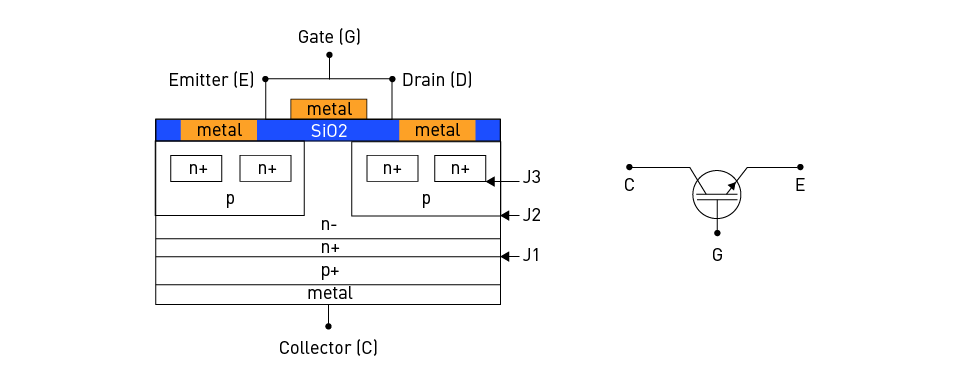Insulated Gate Bipolar Transistor (IGBT)
The Insulated-Gate Bipolar Transistor (IGBT) is a semiconductor device with three terminals that combines the characteristics of both Bipolar Junction Transistors (BJTs) and Metal-Oxide-Semiconductor Field-Effect Transistors (MOSFETs). These characteristics include high input impedance and low on-state conduction losses, making IGBTs suitable for high-voltage and high-current applications.
IGBT Structure
The diagram in Figure 15 illustrates the configuration of an N-channel insulated-gate bipolar transistor (IGBT). The metallic connections link the collector, emitter, and gate terminals to the structure. The IGBTs possess their intended operational traits due to the presence of four alternating layers (PNPN).

Figure 17. Structure and symbol of N-channel IGBT
IGBT Operation
IGBT functions in two primary modes, namely forward blocking mode and conduction mode, which are determined by the relative voltages of the collector, emitter, and ground. When the gate and emitter are at ground potential, and the collector has a positive voltage, J1, and J3 become forward biased, while J2 is reverse biased, thereby placing the IGBT in forward blocking mode, which prevents the flow of current. Conversely, when the gate and collector have a positive voltage, and the emitter is grounded, the voltage applied to the gate causes an inversion effect, which creates a channel by connecting the n+ and n- materials near the gate. This results in the electrons in the n+ region being pushed toward the center of the n- region, also known as the drift region, thereby lowering the potential at junction J1 and causing the holes to flow into the central n-region. This ultimately leads to a plasma of holes, which forward biases the device and allows for the conduction of current.

Figure 18. Simplified equivalent circuit of N-channel IGBT
The operation of an IGBT can be understood through a simplified equivalent circuit, as shown in Figure 16.
As can be seen, if the MOSFET does not fire (i.e., if VGE < VTH), the BJT does not conduct. On the other hand, if VGE > VTH, indicating that the MOSFET is switched on, the BJT will conduct because a current path is created to the BJT base, allowing current to flow through the base of the BJT.
IGBT Characteristics
The fundamental attributes of an IGBT are its transfer and output characteristics.

Figure 19. IGBT transfer characteristics
The transfer characteristics of an IGBT, as illustrated in Figure 17, demonstrate the relationship between Ic and VGE. The transfer characteristics of IGBTs and MOSFETs share similarities. The flow of collector current necessitates a minimum threshold voltage, VTH, between the gate and emitter. The IGBT remains in the off-state when the gate-emitter potential is below the threshold voltage. Conversely, when the gate voltage exceeds the threshold voltage, the transfer curve displays linearity across a significant portion of the drain current.

Figure 20. IGBT output characteristics
The output characteristics of an IGBT, specifically the relationship between collector current (Ic) and collector-emitter voltage (VCE), are depicted in Figure 18. While the output characteristics of a MOSFET are comparable to those of a BJT, the controlling variable for an IGBT is VCE, as it is a voltage-controlled device. The concept of turn-on and turn-off times also applies to IGBTs, similar to MOSFETs.
IGBT Application
IGBTs are extensively employed in a diverse range of high-power applications.
- Motor drives: IGBTs are integral components in the regulation and control of electric motor speed across a wide range of industries, including automotive, aerospace, and consumer appliances. In the context of motor drives, IGBTs are employed in Voltage Source Inverters (VSIs) to convert a fixed DC voltage into an AC voltage with variable frequency and amplitude. This AC voltage is then utilized to govern the speed and torque of the motor. The high current handling capacity and rapid switching speeds of IGBTs facilitate efficient and precise motor control, thereby enhancing performance, energy efficiency, and reducing maintenance expenses.
- Power supplies: IGBTs are frequently employed in switching power supplies for high-voltage and high-current applications, including welding equipment, uninterruptible power supplies (UPS), and high-power DC-DC converters. The low on-state voltage drop and high switching speed of IGBTs are instrumental in enhancing efficiency and reducing heat dissipation in power supply systems.
- Renewable energy systems: In solar and wind power systems, inverters utilize Insulated Gate Bipolar Transistors (IGBTs) to convert the fluctuating DC power generated by solar panels or wind turbines into AC power. The use of IGBTs in these applications facilitates the swift and accurate regulation of voltage and current waveforms, which is crucial for the maintenance of maximum power point tracking (MPPT) and the achievement of efficient energy conversion.
- Electric vehicles: IGBTs are used in the traction inverters of electric vehicles (EVs), as these inverters are responsible for regulating the power that is supplied to the motors that propel the vehicle. The high voltage and current ratings of IGBTs enable them to effectively manage the high-power demands of electric vehicle propulsion systems. Additionally, their rapid switching speeds and minimal on-state voltage drop contribute to enhanced efficiency and decreased heat generation, which are critical factors in extending the driving range and battery life of electric vehicles.
- Power grid equipment: IGBTs are widespread in power grid equipment, particularly in High-Voltage Direct Current (HVDC) transmission systems and Flexible AC Transmission Systems (FACTS). In HVDC systems, IGBTs are employed in Voltage Source Converters (VSCs) to transform Alternating Current (AC) power into Direct Current (DC) power for efficient transmission over long distances. FACTS devices, such as Static Synchronous Compensators (STATCOMs) and Static VAR Compensators (SVCs), use IGBTs to regulate the flow of reactive power in the grid with high precision and speed. This results in improved power quality, stability, and reliability.


直接登录
创建新帐号